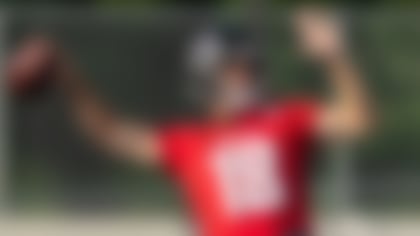If the New Orleans Saints are to follow the NFC South's well-established tradition of going from worst-to-first, Gregg Williams will be the one to guide their path.
The Saints' new defensive coordinator was hired to remake a porous defense that was chiefly responsible for the team failing to make the playoffs for the second straight year. Not only did the Saints rank 23rd in yards allowed and pass defense last season, but they yielded 117.8 rushing yards per game and surrendered the seventh-most points per game (24.6).
Saints go on defensive
From hiring a new coordinator to drafting Malcolm Jenkins, the Saints have made a concerted effort to shore up the defense. Steve Wyche asks: Will it work? More ...
If those woes weren't enough for Williams to handle, he joins a team in a division that features two of the NFL's best rushing attacks (the Atlanta Falcons and Carolina Panthers ranked second and third, respectively, in rushing offense last season) and a Tampa Bay Buccaneers offense that has been significantly improved during the offseason.
Furthermore, the Falcons (wide receiver Roddy White and tight end Tony Gonzalez), Panthers (wide receiver Steve Smith) and Buccaneers (wide receiver Antonio Bryant and tight end Kellen Winslow II) feature Pro Bowl-caliber weapons in their passing games. Thus, the defensive wizard has his work cut out for him in New Orleans.
Williams, who previously directed top-tier defenses with the Tennessee Oilers/Titans and Washington Redskins, comes to the Saints with a reputation for building aggressive, attack-style units that excel at creating turnovers. Though he is coming off a disappointing season with the Jacksonville Jaguars (the team ranked 17th in total defense in 2008), Williams is lauded for his ability to generate pressure on the quarterback with exotic blitz schemes. Furthermore, his attacking style often shoots linebackers into run gaps, which helps his units rank among league leaders in rush defense.
In New Orleans, Willams inherits a unit that has talented players capable of thriving in his high-pressure defense. Will Smith, a former Pro Bowler, and Charles Grant comprise a formidable defensive end tandem adept at rushing the passer and stuffing the run. Though both are coming off sub-par years (Smith recorded a career-low three sacks, and Grant missed eight games because of an injury) and face possible four-game suspensions to open the season, they are potential double-digit sackers off the edge. They are joined by last year's first-round pick, Sedrick Ellis, along the line. Ellis showed promise as an interior rusher and could blossom as a one-gap player in Williams' scheme.
Former Pro Bowler Jonathan Vilma is expected to play a prominent role as the Saints' MIKE linebacker. An instinctive playmaker with a strong nose for the ball, Vilma has always finished as one of the league's leading tacklers, and that trend should continue in a 4-3 scheme designed to allow him to run unobstructed to the ball.
While the Saints have solid complementary players in other positions, their front seven could receive an unlikely boost from two former Pro Bowlers who missed all of 2008. Rod Coleman and Dan Morgan join the team after spending one year away from the game and bring a wealth of experience and some potential playmaking ability.
Coleman, a Pro Bowler in 2005, has tallied 58.5 sacks in his nine-year career, including 52.5 from 2001 to 2007, the most of any defensive tackle in the league during that span. Although he has been plagued by injuries the last two years, Coleman could provide some production as a situational interior rusher in certain packages.
Morgan, a seven-year veteran and one-time Pro Bowler, has fought injuries throughout his career, but he flashed dominant ability when healthy. If he can overcome the numerous injuries that led to his brief retirement last year, Morgan gives the Saints a speedy, ball-hawking linebacker to add to their rotation. As a low-risk, high-reward proposition, Morgan could be the wild-card player who takes the team's defense to another level.
The Saints' front seven played a role in the team's defensive struggles last season, but the secondary was the biggest culprit. Plagued by blown assignments and spotty coverage, the Saints allowed 53 pass completions over 20 yards, which ranked as the third-most in the league. Sure, the team's invisible pass rush didn't help (the Saints tied for 22nd in the league in sacks with 28), but the defensive backs too often let receivers run free through the zone. Shoring up the leaky back-end play was the Saints' offseason emphasis, so they signed safety Darren Sharper and cornerback Jabari Greer in free agency and took defensive back Malcolm Jenkins in the draft.
Sharper, a 12-year veteran with 54 career interceptions, gives New Orleans a ball hawk in the middle of the secondary. Though the four-time Pro Bowler has lost a step, he still possesses the instincts and awareness to actively patrol the back end.
In Greer, the Saints acquire a veteran with solid overall skills. While few outside of Buffalo, where he spent his first five NFL seasons, appreciate his skills, Greer is an underrated cover man with good instincts and awareness. He is adept at playing in man or zone coverage and gives Williams an ideal cornerback to use in his adaptable scheme.
Jenkins, the Saints' first-round draft pick, is a versatile pass defender with the skills to play cornerback or safety. That flexibility gives Williams the option to use Jenkins inside or outside in the team's sub-package. This not only increases Jenkins' chances of being matched up with the opponents' top weapon but creates the possibility of him being incorporated into the Saints' pressure package. Williams used Shawn Springs in that role with the Redskins, and Jenkins' skills make him the model candidate to fill the position in New Orleans.
With the aforementioned trio joining two promising cornerbacks (Randall Gay and Tracy Porter) and a hard-hitting safety (Roman Harper) in the Saints' secondary, Williams has personnel in place to implement the varied coverage packages that often befuddle quarterbacks. From Cover 0 (all-out blitz without safety help in the middle of the field) to Tampa 2, the Saints are set to unveil a multi-faceted defense that changes from play to play to keep offenses on their heels.
After failing to reach the playoffs the past two years, the Saints might go marching into the postseason in 2009 behind a rebuilt defense and an aggressive coordinator.




